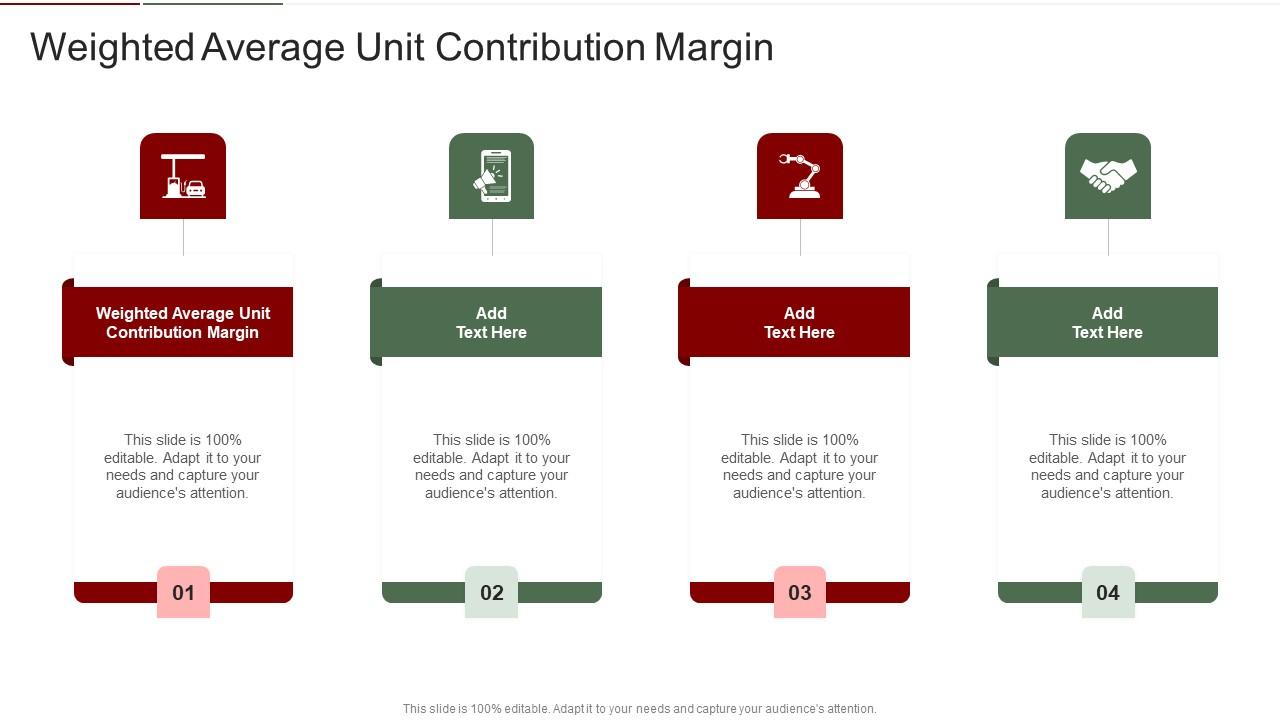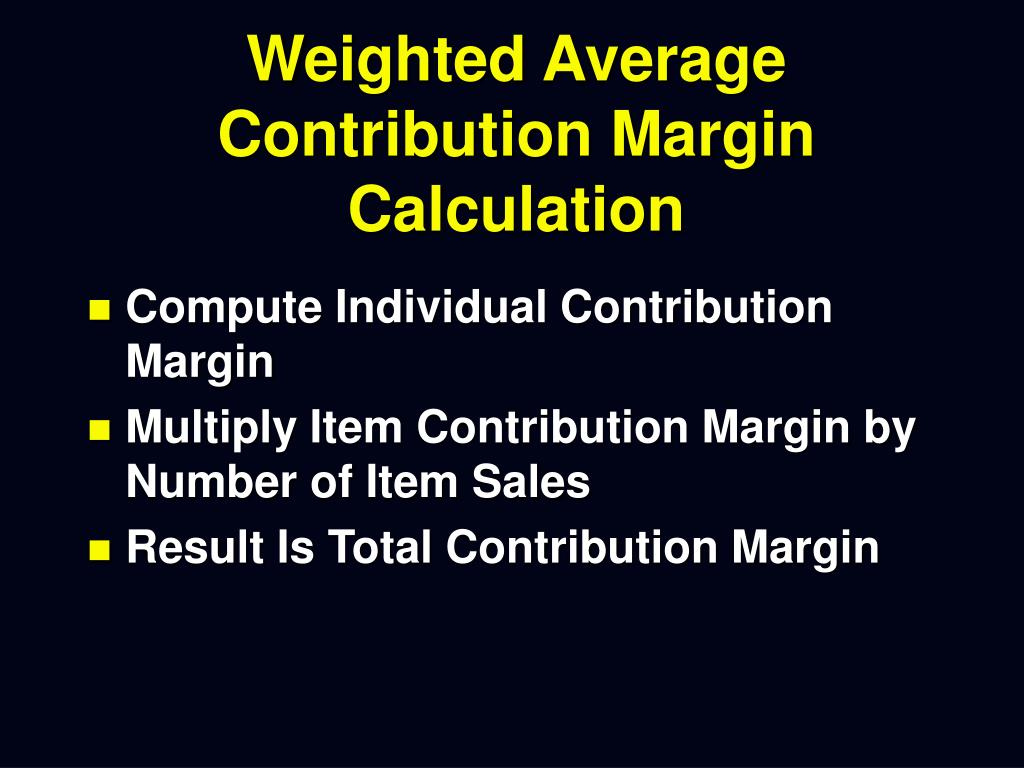
To bring the cumulative total back down to small and large units, you create a fraction for each product line consisting of unit sales to overall sales. Calculating the weighted average contribution margin can provide business owners valuable information about different products and services that they offer. Knowing the weighted average contribution margin can give managers insight into how much they should cut costs or raise prices to meet financial goals without sacrificing customer satisfaction. For example, if the contribution margin of 6,000 pairs of sandals is $114,000 and the contribution margin of 4,000 pairs of shoes is $95,000, your total contribution margin will be $209,000.
Contribution Margin vs. Gross Profit Margin
These costs may be higher because technology is often more expensive when it is new than it will be in the future, when it is easier and more cost effective to produce and also more accessible. A good example of the change in cost of a new technological innovation over time is the personal computer, which was very expensive when it was first developed but has decreased in cost significantly since that time. The same will likely happen over time with the cost of creating and using driverless transportation.
An Overview of the 6 Types of Investment Accounts
Say that a company has a pen-manufacturing machine that is capable of producing both ink pens and ball-point pens, and management must make a choice to produce only one of them. Break-even analysis is an important technique used to determine the budget a business needs to remain financially healthy, but it can be difficult to apply accurately when dealing with multiple products. Then, weigh each of those contribution margins in correlation to their individual sales quantities before summing them together and dividing by the total number of products sold. Multiply the number of each product type you expect to sell by their sales prices to get the sales revenue for each product type. For example, if you sell 6,000 pairs of sandals for $20 a pair, you will get sales revenue of $120,000 from sandals. By carefully analyzing market demand and competitors’ pricing strategies, businesses can identify opportunities to optimize their prices for maximum profitability.
Fixed Cost vs. Variable Cost
The analysis can provide useful forecasts for the company to examine the variable costs and increase its contribution. Multiply each unit contribution margin by the product’s share of sales by volume. For example, if you have a product with a contribution margin of $10 and it has a market share of 25 percent, you would get a weighted contribution margin of $2.50. The goal of just about every business is making a profit, and break-even analysis helps you understand just how much business you need to do to reach that goal. When you sell more than one thing, as most business do, break-even analysis relies on a figure called “weighted average contribution margin” to tell you how much closer to profitability you get with each sale.
The 5 Critical CPA Exam Study Strategies You Need to Be Doing
Amy’s Accounting Service must achieve $822,222 in sales to earn $250,000 in profit. This weighted average C/S ratio can then be used to find CVP information such as break-even point, margin of safety, etc. For instance, dynamic pricing techniques, such as surge pricing during peak demand periods or personalized pricing based on customer segments, have proven successful in driving revenue growth. By implementing these targeted actions, companies can take concrete steps towards improving their Weighted Average Contribution Margin. This article explores the significance of this metric, its impact on decision making, and the key differences between Weighted Average Contribution Margin and regular Contribution Margin.
Identify Products to Sell
- Figure 1 shows a typical break-even chart for Company A. The gap between the fixed costs and the total costs line represents variable costs.
- Understanding the Weighted Average Contribution Margin can assist in making informed decisions regarding pricing strategies, resource allocations, and product mix to drive sustainable growth.
- Deduct the variable cost of each product type from the sales revenue to obtain the contribution margin for each product.
- The company will use this “margin” to cover fixed expenses and hopefully to provide a profit.
- Based on the contribution margin formula, there are two ways for a company to increase its contribution margins; They can find ways to increase revenues, or they can reduce their variable costs.
- It is also important to regularly review and update the contribution margins used in the calculation to ensure accuracy.
Another common example of a fixed cost is the rent paid for a business space. A store owner will pay a fixed monthly cost for the store space regardless of how many goods are sold. When you want to move past breakeven calculations and factor in operating income, simply add the profit you want to realize to fixed expenses before moving forward.
Sales volume, however, is not usually so predictable and therefore, in the short-run, profitability often hinges upon it. For example, Company A may know that the sales price for product X in a particular year is going to be in the region of $50 and its variable costs are approximately $30. The gocardless can provide useful forecast information on break-even sales and volume. The company can estimate the sales mix units and adjust the production of the most profitable products.
This is particularly beneficial in strategic planning, as it helps in identifying which products are generating the most value and where adjustments may be needed to optimize profitability. Understanding the Weighted Average Contribution Margin can assist in making informed decisions regarding pricing strategies, resource allocations, and product mix to drive sustainable growth. The weighted average contribution margin is useful for calculating the number of units that a business must sell in order to cover its fixed expenses and at least break even, if not earn a profit. ABC International has two product lines, each of which is responsible for 50% of sales. The contribution from Line A is $100,000 and the contribution from Line B is $50,000.

Weighted Average Contribution Margin is crucial for assessing a company’s financial performance as it provides a more accurate representation of profitability by considering the varying contributions of different products or services. We can calculate the total sales, weighted average contribution margin, and the break-even point per unit or sales as below. Let us suppose a company green Star produces 4 different products with the following data. The fixed costs for the company remain $ 300,000 for the production period.
The Weighted Average Contribution Margin reveals insights into a company’s financial health, profitability, and strategic positioning by analyzing the relationship between revenue, costs, and overall business performance. The graph can then be drawn (Figure 3), showing cumulative sales on the x axis and cumulative profit/loss on the y axis. It can be observed from the graph that, when the company sells its most profitable product first (X) it breaks even earlier than when it sells products in a constant mix.
Buying items such as machinery is a typical example of a fixed cost, specifically a one-time fixed cost. Regardless of how much it is used and how many units are sold, its cost remains the same. However, these fixed costs become a smaller percentage of each unit’s cost as the number of units sold increases. The weighted-average contribution margin is a measure used in multi-product environments to determine the average contribution margin across all products, weighted by their respective sales volumes. It provides a holistic view of the profitability of a company’s product mix and is an important factor in performing break-even sensitivity analysis.


